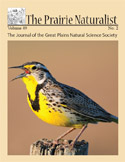Great Plains Natural Science Society

The Prairie Naturalist
Date of this Version
12-2011
Document Type
Article
Citation
The Prairie Naturalist 43(3/4):100–109. December 2011
Abstract
Two United States Army Corp of Engineers- (USACE) funded projects were conducted from 2006 to 2008 along the Missouri River to monitor fish communities in recently constructed side-channel chutes and to monitor pallid sturgeon (Scaphirhynchus albus) and the associated fish assemblage in the main stem Missouri River. Data from both monitoring projects were compared to evaluate fish assemblages among four mitigated habitats (e.g., constructed side-channel chutes) and the main-stem Missouri River. Chutes had a greater overall number of species (n = 59) and higher species richness (Margalef’s index = 5.81), but richness was not different (F1, 4 = 0.23, P = 0.22) between chutes and the Missouri River main channel. Non-metric multidimensional scaling (NMDS) showed fish assemblages in side-channel chutes separated out from that of the main river, likely due to chutes having a few unique species that were not sampled in the main river. Relative abundance of native cyprinids that are important food items for pallid sturgeon [e.g., Shoal chub (Macrhybopsis hyostoma), sturgeon chub (M. gelida), silver chub (M. storeriana), sand shiner (Notropis ludibundus), and river shiner (N. blennius)] all showed a decline in the Missouri River during the period of study but were stable or increased in Upper Hamburg Chute (oldest constructed side-channel chute). Relative abundances of these species in the remaining chutes were variable over time with the exception of silver chub and river shiner, which declined across years in Kansas and Deroin side-channel chutes. Ongoing development of habitat complexity and diversity in these chutes may eventually lead to a more diverse and abundant fish assemblage.
Included in
Biodiversity Commons, Botany Commons, Ecology and Evolutionary Biology Commons, Natural Resources and Conservation Commons, Systems Biology Commons, Weed Science Commons


Comments
Published by the Great Plains Natural Science Society, 2011. Used by permission.